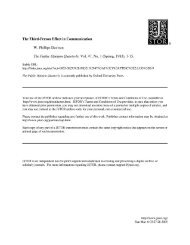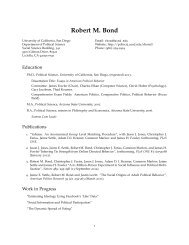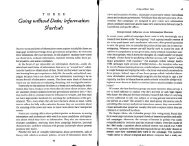Chapter 6 Why Authoritarian Parties? The Regime Party as an ...
Chapter 6 Why Authoritarian Parties? The Regime Party as an ...
Chapter 6 Why Authoritarian Parties? The Regime Party as an ...
You also want an ePaper? Increase the reach of your titles
YUMPU automatically turns print PDFs into web optimized ePapers that Google loves.
CHAPTER 6<br />
parties that on average control about three-fourths of all legislative seats. Two examples of<br />
well-known observations in this subgroup are the PRI in Mexico during the period between<br />
1946 <strong>an</strong>d 1987 <strong>an</strong>d Golkar in Indonesia under Suharto (1971-1998). <strong>The</strong> observations in this<br />
subgroup thus correspond to a conceptual category that h<strong>as</strong> been alternately referred to <strong>as</strong><br />
domin<strong>an</strong>t parties (Greene 2007; Magaloni <strong>an</strong>d Kricheli 2010; Reuter <strong>an</strong>d G<strong>an</strong>dhi 2010) or<br />
hegemonic parties (Magaloni 2006; Blaydes 2010).<br />
<strong>The</strong> second largest of these three groups h<strong>as</strong> the me<strong>an</strong> legislative seat share of 51.39%<br />
<strong>an</strong>d accounts for roughly one-fifth of all observations. In this group, the regime party h<strong>as</strong><br />
close to a bare majority or minority in the legislature. One prominent observations in this<br />
subgroup is the Kenya Afric<strong>an</strong> National Union (KANU) after D<strong>an</strong>iel Arap Moi restored<br />
multiparty elections in 1992; KANU controlled 53% <strong>an</strong>d 51% of legislative seats in the<br />
two terms between 1992 <strong>an</strong>d 2002. Another example is the PRI which only controlled<br />
52% <strong>an</strong>d 48% of legislative seats in the Mexic<strong>an</strong> Chamber of Deputies for parts of Carlos<br />
Salin<strong>as</strong>’s <strong>an</strong>d Ernesto Zedillo’s presidencies. 32 As these c<strong>as</strong>es illustrate, signific<strong>an</strong>t legislative<br />
opposition exists in this subgroup of regimes, even if it is divided. Hence the political setting<br />
under which regime parties in this subgroup operate may be conceptually characterized <strong>as</strong><br />
“electoral authoritari<strong>an</strong>ism” (Schedler 2006) or “competitive authoritari<strong>an</strong>ism” (Levitsky<br />
<strong>an</strong>d Way 2002).<br />
<strong>The</strong> l<strong>as</strong>t of these three groups may seem somewhat perplexing: with the me<strong>an</strong> legisla-<br />
tive seat share of only 19.57%, the authoritari<strong>an</strong> leader’s party is hardly in charge of the<br />
legislature. However, once we examine the observations corresponding to this group, we see<br />
that they primarily reflect temporary tr<strong>an</strong>sitional scenarios, in which either a democracy just<br />
32 This are the legislative terms of 1988-1990 <strong>an</strong>d 1998-2000, respectively.<br />
47











